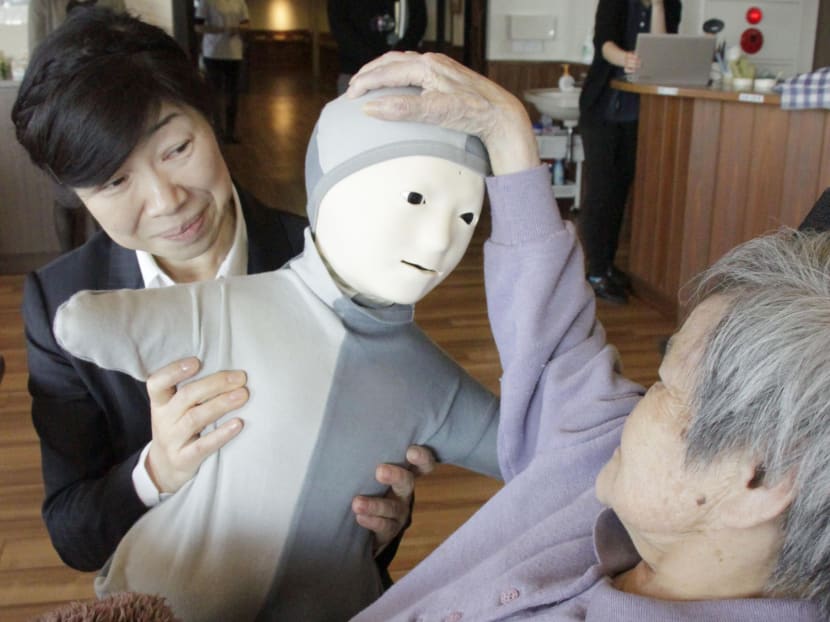Humanoid robots, IT help improve elderly nursing quality
Humanoid robots and advances in information technology are helping to improve the quality of life for the elderly, especially those with dementia.

An elderly woman pats a Telenoid robot on the head at a nursing care facility in Natori, Miyagi Prefecture, northeastern Japan. A woman in the right back operates the robot. Photo: Kyodo News
TOKYO — Humanoid robots and advances in information technology are helping to improve the quality of life for the elderly, especially those with dementia.
A nursing home in Natori, Miyagi Prefecture, north-east of Tokyo, has enlisted the help of the Telenoid robot, through which carers can communicate with the elderly as if the little robot was talking to them.
A smartphone app that can help family members or nursing facilities track down people with dementia who have gone missing has also come into use. By downloading the app, people in the community can help conduct group searches to find a missing elderly person.
“Grandma, what colour flowers do you like?” asked the remote-controlled Telenoid robot of a resident in her 80s at the Urayasu elderly nursing home in early April. “Pink cherry blossoms,” the woman responded with a smile.
The Telenoid robot, which weighs 2.7kg and is 50cm tall, was developed by Osaka University Professor Hiroshi Ishiguro and his associates. Urayasu became the first nursing home nationwide to incorporate the humanoid in February.
The humanoid has nubs for hands and feet. It has a faceless expression, no age, and is sexless — features included to allow users to focus on expressing themselves more thoroughly.
The operator can communicate with the elderly person remotely with a microphone and camera, which captures the voice and movements of the person and projects them through the Telenoid. It has a robotic voice and can move its head from side to side.
Ms Maki Hashimoto, a 31-year-old staffer at the nursing home, said a resident who used to be irritable has changed her disposition for the better. “She makes (mild) gestures now,” Ms Hashimoto added.
The nursing home said the elderly who have advanced stages of dementia, in particular, are convinced of the Telenoid’s human qualities. In a trial of the Telenoid at another facility, an elderly person whose young son died decades ago was brought to tears, apparently because of the interaction with the humanoid.
Mr Utako Miyazaki, who is leading an effort with a Kyoto-based company to popularise the humanoids, said the Telenoid can help the elderly suffering from dementia see “sustainability and improvement in ... cognitive functions”.
Along with the humanoid, a smartphone app has been developed by Safety Net Linkage, a Sapporo-based company.
For the “Mimamori Eye” (“Watching Over”) app, families or nursing facilities can register an elderly person, detailing their physical features, and optionally provide a facial photo. People who wish to get involved can download the app and register.
When a search request is made, the information on the missing person can be sent to the smartphones of people who have volunteered within a 20km radius. The company has set up a hotline to directly call the party that commenced the search if a missing person is found.
The service is free and is already being employed in Hachioji, a Tokyo suburb, and Fuefuki in Yamanashi Prefecture. Kashiwa in Chiba Prefecture is planning to introduce the system.
“We want to develop this broad framework across municipalities nationwide,” said Mr Tatsuya Takahara, the representative director of Safety Net Linkage.
More nursing facilities are implementing the latest technology where they used to rely on human staff. Systems are in place that use facial recognition or sensors that sound alarms when an elderly person has left a bed, for example, and other devices to lessen the burden of nursing care.
After conducting an analysis on data collected, the Health, Labour and Welfare Ministry is considering rewarding businesses that incorporate robots as part of a revision for long-term care fees in fiscal 2018.
KYODO NEWS





